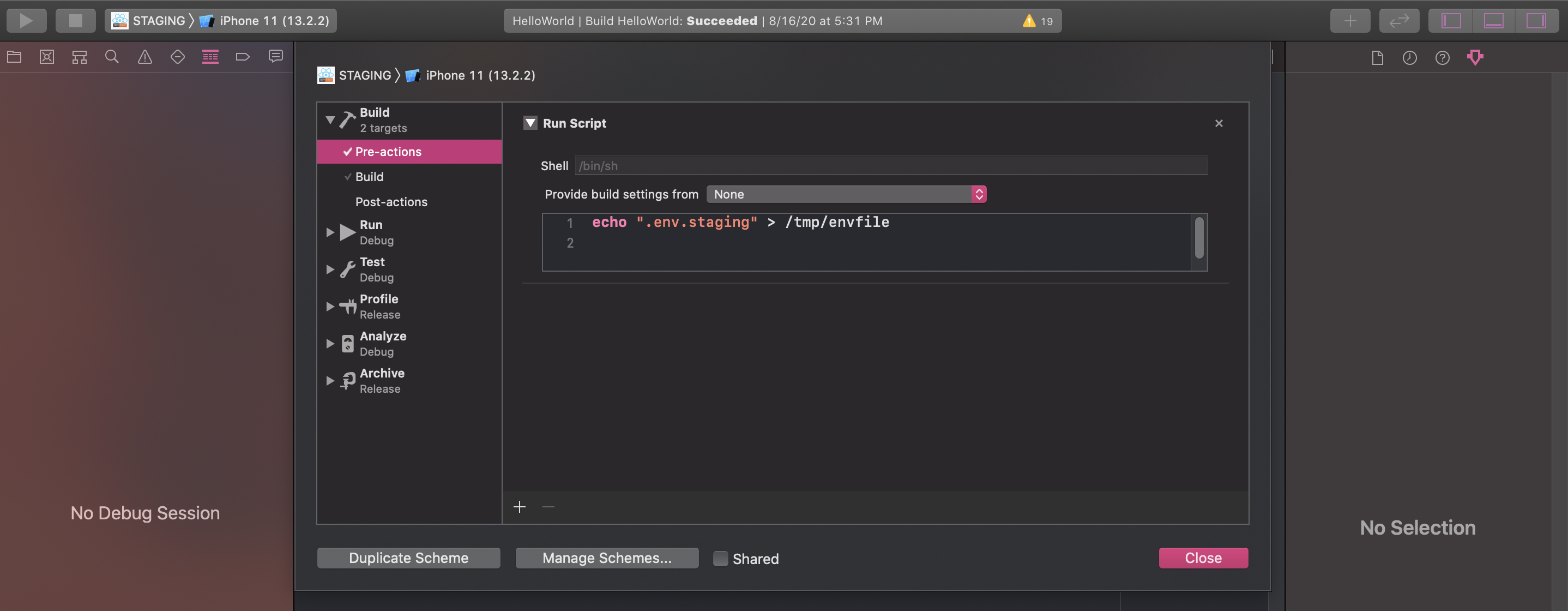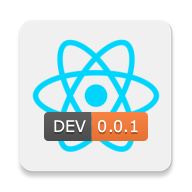react-native-template
An opinionated template to bootstrap your next React Native app with all the time-wasting packages you need to have.
💻 Contributions are very welcome 🤝
Let's build the best React Native template together 🚀
Preconfigured with
- Synced with the recommended TypeScript template
- Storybook The UI component explorer. Develop, document, & test React Native components
- React Query for api calls
- Axios for fetch api calls
- Redux Toolkit for global state.
- React Navigation (v5) for navigation and deeplinking.
- styled-components
- styled-system
- react-native-bootsplash because splash screens are cool.
- react-native-svg because svg.
- react-native-config to manage separate environments (dev, staging, production).
- Reanimated for animations.
- react-native-keychain for Keychain/Keystore access.
- react-native-permissions unified permissions api for iOS and Android.
- NetInfo Network Info API for Android, iOS, macOS & Windows.
- react-native-appstate-hook handle app state in your app.
- react-native-file-logger to log important stuff.
- react-i18next internationalization.
- AsyncStorage you're gonna install it anyway.
- FastImage its more performant
- Mirage JS the easiest way to mock APIs.
- Fastlane for automation.
- Code Push syncronize JavaScript and Images with over-the-air updates.
- handy npm scripts.
- react-native-testing-library for unit and component tests.
- Sentry for debugging in production.
- Detox for e2e.
Contents
Documentation
Getting Started
Create a new project using the template.
- Note: the command will fail if you have the global legacy react-native-cli installed. Make sure you uninstall it first. More info at react-native-community/cli.
RN 0.64.1
$ npx react-native init MyApp --template @hmarques98/react-native-template-typescriptRoad Map
- Finish Detox integration
- Add Docusaurs docs
- Codepush Code Signing
Optional Steps
Connect To Sentry
This template comes with Sentry, but its disabled until you connect your account.
To connect your account:
$ cd MyApp/
# For MacOS
$ npx sentry-wizard -i reactNative -p ios android
# Other Platforms
$ npx sentry-wizard -i reactNative -p androidInsert your sentry DSN in each .env file (dev, staging and production) and you're all done.
Setup deep linking scheme
Implementation was based on react-navigationinstructions.
-
Update the prefix with wanted URI in
App.tsx -
iOS
Update CFBundleURLName and CFBundleURLSchemes to your desired URI
- Android
Update android:scheme value inside <data> tag from the <intent-filter>
Enable Push Notification capability from Xcode
You must be a member of the Apple Developer Program in order to enable Push Notifications
Customize notification appearance on Android
Starting Android 10 (API 29), notification icons should be glyphs. You need to follow this step to customize the notification appearance.
Setup Code Push
-
You will need to have AppCenter CLI installed
-
Creating an AppCenter account and/or organization and create an app for each platform and environment
-
Copy and Replace the CodePushDeploymentKey in android/app/build.gradle under
buildTypes -
Copy and Replace the CodePushDeploymentKey in android/app/build.gradle and XCode -> YourProject -> Build Settings ->
CODE_PUSH_KEY
You can retrieve this values by running appcenter codepush deployment list -a <ownerName>/<appName> -k
Add project email for the FileLogger
Update project email used by sendLoggedFiles method in Home.tsx
Libraries
Let's briefly go over the benefit of each library included in this template.
TypeScript
For type safety ¯\(ツ)/¯
But in all seriousness, if you are considering this template I assume you are a TypeScript fan. If you happen to be a JavaScript user, this template might be overwhelming. If you would like to start learning TypeScript, I suggest bootstrapping with this instead react-native-community/react-native-template-typescript so you can learn at your own pace.
styled-components
Style your apps without stress with dynamic styling and painless maintenance. styled-components utilises tagged template literals to style your component. Checkout this Getting started tutorial.
styled-system
Styled System is a collection of utility functions that add style props to your React components and allows you to control styles based on a global theme object with typographic scales, colors, and layout properties. Checkout this Getting started tutorial.
React Query
Hooks for fetching, caching and updating asynchronous data in React.
- Alternative: SWR/Apollo.
AXIOS
I like to used axios because your interceptors configurations.
Redux/Redux Toolkit
I'm happy using Redux Toolkit. It's a lot more concise now and I enjoy the redux ecosystem of plugins.
SWR reduces our dependency on Redux for global state. And sometimes React Navigation can be used to send data to the next screen. I try to leverage these two before reaching out to global state.
If you prefer something else, remove redux and go with that. Do not waste time trying a new state management solution.
React Navigation
It is the most popular navigation library. For most apps, this is the best choice.
react-native-keychain
Save and use credentials from phone's Keychain/Keystore
react-native-permissions
A unified permissions API for React Native on iOS and Android. For iOS you have to the Podfile with permissions pod and update Info.plist with wanted permissions descriptions. For Android add wanted permissions in AndroidManifest.xml
react-i18next
Localization using hooks. React Native example
Codepush
A React Native app is composed of JavaScript files and any accompanying images, which are bundled together by the packager and distributed as part of a platform-specific binary (i.e. an .ipa or .apk file). Once the app is released, updating either the JavaScript code (e.g. making bug fixes, adding new features) or image assets, requires you to recompile and redistribute the entire binary, which of course, includes any review time associated with the store(s) you are publishing to.
The CodePush plugin helps get product improvements in front of your end users instantly, by keeping your JavaScript and images synchronized with updates you release to the CodePush server. This way, your app gets the benefits of an offline mobile experience, as well as the "web-like" agility of side-loading updates as soon as they are available. It's a win-win!
Sentry
Benefitial in debugging issues that occur only in release builds. You can view error stack traces for unhandled exceptions. You can also choose to log specific errors in some catch blocks to study how often they occur in production.
In this template, there is a custom Redux middleware that adds Redux actions as breadcrumbs to Sentry reports for even easier debugging.
This is similar to redux-sentry-middleware but I've yet to test that one.
react-native-bootsplash
Works great for controlling your splash screen. To help about lib
$ npx react-native generate-bootsplash --helpFull command usage example to put your SplashScreen
npx react-native generate-bootsplash assets/splash.png \
--background-color=F5FCFF \
--logo-width=100 \
--assets-path=assets \
--flavor=mainOnly iOS follow this instructions from library BootSplash
where is saying Set the BootSplash.storyboard as launch screen file:
react-native-svg
Prefer using SVG over images all the time (remember to optimize your SVGs).
react-native-config
If you have different development, staging and production variables, this library is very helpful. It allows you to declare environment variables that can be accessed by all 3 sides (android, ios, JavaScript).
Android: by default, running react-native run-android will use the development .env file. To load .env.staging we must use:
ENVFILE=.env.staging react-native run-android
Note: the above works on MacOS. For windows its a bit different. See Different Environments.
iOS: two additional schemes are created in the Xcode project for staging and production. The corresponding .env file is set via the scheme's pre-action:
NPM scripts for running the app with the desired configuration are included for convenience.
Reanimated/Redash
Necessary when creating complex gesture based animations that are highly performant. Redash contains boilerplate helpers for Reanimated.
react-native-appstate-hook
Custom react hook, built to handle iOS or Android appState in your react component.
react-native-file-logger
A simple file-logger for React Native with configurable rolling policy, based on CocoaLumberjack on iOS and Logback on Android.
AsyncStorage
For caching simple data such as user perferences.
FastImage
Drop in replacement for the <Image/> component. I've found this to give a performance boost on android when rendering many images.
NetInfo
Network Info API for Android, iOS, macOS & Windows. It allows you to get information on:
- Connection type
- Connection quality
react-native-testing-library
For unit and component testing.
Detox
For end-to-end testing.
Mirage JS
Mirage is an in-memory server for intercepting API calls and returning whatever data you want. Very useful for developing before the backend is deployed, and for confirming how the app reacts to different API call outcomes.
Fastlane
Fastlane community has an endless amount of mobile development automation plugins. I currently use it mainly for automatic versioning, and often for deploying to Microsoft's App Center in one command.
This template also has a fastlane command for adding version badges to app icons. Useful outside of production as it makes it easier for QA to tell the app version.
If you appreciate those libraries and find them useful, please consider supporting them.
Directory Structure
root
├── __tests__
├── android
├── ios
├── storybook
| └── addons.js
| └── index.js
| └── rn_addons.js
└── src
└── components
| └── Counter.tsx
| └── CustomScreen.tsx
| └── CustomText.tsx
| └── LanguageButton.stories.tsx
| └── LanguageButton.tsx
| └── StatusBar.tsx
| └── stories.ts
└── hooks
| └── useCustomBackBehaviour.tsx
| └── useNetworkError.tsx
| └── useNotification.tsx
| └── usePrevious.tsx
| └── useStartupTime.tsx
| └── useReactQuery.tsx
└── localization
| └── resources
| | └── en.json
| | └── index.ts
| | └── ro.json
| └── index.tsx
└── modules
| └── auth
| | └── hooks
| | | └── useKeychainBiometrics.tsx
| | | └── useKeychainCredentials.tsx
| | | └── useSupportedBiometry.tsx
| | └── screens
| | | └── index.tsx
| | | └── Onboarding.tsx
| | | └── ResetPassword.tsx
| | └── store
| | | └── index.ts
| └── <your_app_modules>
└── navigation
| ├── RootNavigation.tsx
| └── Router.tsx
└── screens
| ├── CustomWebView.tsx
| ├── Home.tsx
| ├── index.ts
| └── NetworkError.tsx
└── utils
├── colors.ts
└── console.ts
└── services
├── axiosConfig.ts
└── styles
├── colors.ts
├── typography.ts
├── spacing.ts
├── index.ts
Credits
This template is modified from react-native-typescript-template and inspired from Osama Qarem's React Native template and also inspired from Gabriel Moncea React Native template
Thank you





